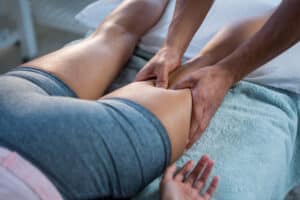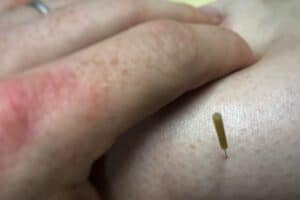Trigger Point & Dry Needling Therapy in Zurich
Patients with constant pain often don't know what to do. The Manual Trigger Point Therapy IMTT® is a method that very often leads to significant improvements in this regard. Most pain has either a muscular or fine fascial trigger, so-called myofascial pain. Trigger point therapy translates the knowledge and findings of Janet G. Travell and David G. Simons about myofascial pain into a manual therapy method.
Patients suffering from chronic pain usually have altered connective tissue. For this reason, the Swiss physician Dr. Beat Dejung from Winterthur has supplemented the treatment concept of Travels and Simons and developed a Swiss approach to trigger point therapy. In this approach, not only the individual trigger points are treated, but also the surrounding tissue through global, manual techniques. The manual techniques are complemented by stretching and relaxation of the muscles and tissues and functional strengthening of the muscles.
Trigger point therapy
Trigger Point Therapy
The Manual Trigger-Point-Therapy IMTT® is performed by specially trained therapists. The hardest strand in the musculature is identified through questioning and findings as well as a muscle test. Through a provocation test, an attempt is made to trigger a pain that is known to you and possibly transferred to another part of the body. This is called "referred pain." If it is your known pain, this point will be treated. We take a very structured approach to this to ensure the best outcome for you. Other trigger point therapy techniques aim to treat the Fascia to other structures. Once the function of the muscle has been restored, it is trained using equipment training or exercises using your own body weight. Additional homework tailored to you supports long-term therapeutic success.
Dry needling
Dry needling
If the manual trigger point therapy is not sufficient for the patient*, the so-called Dry needling the next method, which our therapists perform with great experience. Here, with the help of sterile acupuncture needles, the trigger points are stimulated minimally invasively with the needle. There is a local twitching in the muscles. This is the signal that the muscle resumes its metabolic activity, the hardening subsides and gradually, after a short reaction phase, relief of the pain can occur.
In combination with targeted functional training and stretching and trigger point therapy, long-term improvement can occur here.
Trigger point therapy
The goal of trigger point therapy is to dissolve the existing muscle trigger points. These are deposits that can occur for many reasons. These points are noticeably hardened areas in a contracted muscle.
The most common causes
The reasons for the development of trigger points are often insufficient movement and incorrect stress. The best example is sitting for hours. This includes congenital malpositions that lead to an anatomically unnatural strain. This leads to reduced blood flow and insufficient supply of nutrients to the muscle at these points. Due to these changes, the nerve endings are irritated, which results in pain. As a result, the muscle shortens permanently and can no longer relax, which ends in a myofascial syndrome. To prevent the development of trigger points, the risk factors should be reduced as much as possible. Psychological triggers such as stress should not be underestimated.
Diagnosis
No imaging techniques help with trigger point therapy because you can't see the points that way. Therefore, it is important for us to know your medical history. This is followed by a physical examination. Here you should describe your pain in as much detail as possible and also show us the exact location. It is also important to describe the nature of the complaints and their occurrence. During the physical check, the examiner tests the stretching ability, strength and finds the affected parts of the body by palpation.
Symptoms
Trigger points can cause many different complaints. Typical is a radiating pain when irritated. It is often described as burning, deep and slowly spreading. In others, it is superficial. It can cause problems when swallowing or speaking. It often affects the neck, spine and shoulder joint. In addition to the pain, many patients also suffer from restricted mobility. Due to these unnatural postures and the resulting imbalance, arthritis or osteoarthritis can occur as a late consequence. Sleep disorders are another negative side effect in many cases.
Therapy and treatment duration
The first goal is to dissolve the trigger points. This is done by activating the metabolic processes around the affected area. To perform trigger point therapy, there are different methods. They are both manual methods and treatments with devices. One method that is often used is ischemic compression. In this method, the therapist presses the trigger point with her finger or a trigger stick to induce a stimulus. In this way, a sustained pressure is applied. For patients, it is bearable due to its short duration. In addition to this method, needles (dry needling) are also used. The duration of trigger point therapy depends on the individual case. If there are only a few points to be treated, a few sessions are sufficient. If more complicated cases need to be treated, it takes longer. This is always the case if several muscles are affected or if the problems recur. Basically, the therapy eliminates the pain, but not the cause. Getting to the root of the problem and, in the best case, eliminating it, is crucial. This prevents the reoccurrence of trigger points.
Dry needling therapy
Dry needling means "dry needling" and it does just that. Physiotherapy works with disposable acupuncture needles to relax tense muscles and fascia and stimulate blood circulation in these areas. Trigger points are the painful areas in the muscles or fascia, respectively, that can be felt in the form of hard knots. Dry needling is performed exclusively by experienced physiotherapists, as the procedure requires not only a sensitive hand, but also very good knowledge of anatomy. Dry needling involves pricking the trigger points. Thereupon the area of the muscles reacts reflexively, muscle contractions occur. This reaction must occur if the intramuscular stimulation is to be successful. This is also referred to as a local twitch response. We work with two other dry needling techniques, superficial dry needling or SAS and IMES or intramuscular electrical stimulation. Both the SAS technique and IMES are used depending on the location of pain and tension. In terms of intensity of trigger point stimulation, the three procedures increase in strength in sequence: SAS > Dry Needling > IMES.
Treatment steps of a therapy
- An initial consultation takes place. This appointment allows to discuss the medical history and possible risks for dry needling.
- The new therapy with needles is presented.
- The initial discussions are followed by a detailed examination to determine exactly which muscle parts will be subjected to the treatment.
- After the trigger points are diagnosed, the body is placed in the correct position for therapy. Subsequently, the points are fixed by means of certain grip techniques.
- Now the areas to be treated are disinfected, needled, disinfected again and retreated.
The clientele and their treatment needs
The Dry Needling method is especially interesting for athletes, as they experience increased and repeated muscle tension. Needling is also interesting for people with sedentary jobs, for people with high physical demands, hospital staff and construction workers and for all others whose body reacts to stress and overstrain with physical symptoms. Pain in the muscles can also occur as a result of arthritic complaints. Dry needling is largely painless; the muscle twitch alone may be experienced as uncomfortable. Unlike acupuncture, dry needling involves pricking the trigger points. Acupuncture stimulates the flow of energy and is placed in special points on the meridians that flow through the body as a conduit for life energy. The method of dry needling is a proven alternative to injections with side effects and moderate success for almost all people with muscular complaints.
Patients who take blood thinners, who are allergic to nickel and latex, who have just had surgery in the area of pain, and pregnant women must have the treatment with cold needles approved by a doctor. Even if you are in good health, please note that the injection sites may remind you of the treatment for a few days with minor sensitivities. In this case, we recommend taking warm baths, being a little more considerate of yourself in everyday life and doing the recommended stretching exercises of the affected muscles in your free time.


